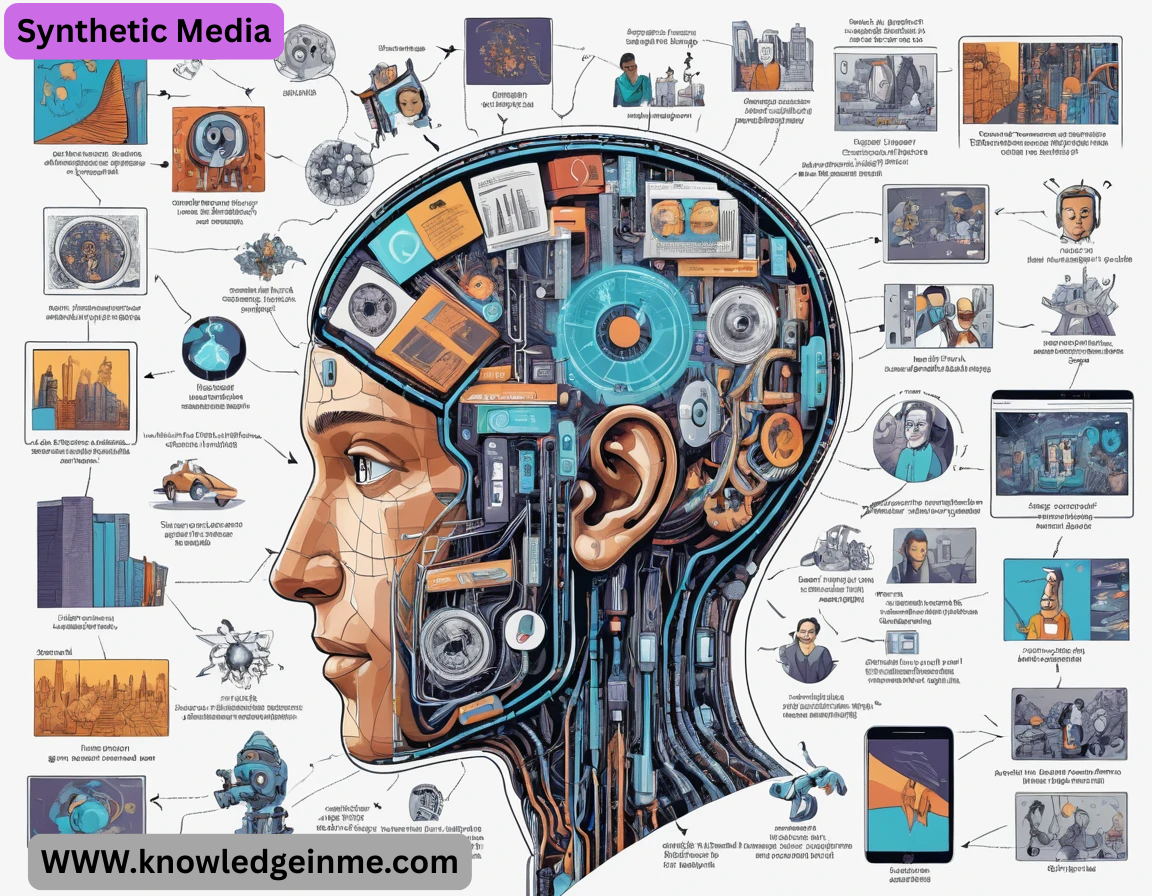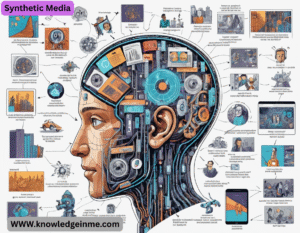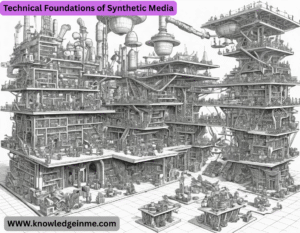Synthetic Media Unlike traditional media, which is created by humans, synthetic media is produced by algorithms, often with minimal human input. This technology enables hyper-realistic but entirely artificial content, raising both opportunities and ethical concerns.
Types of Synthetic Media
Deep fakes
- AI-generated videos or images that realistically replace a person’s face or voice with another (e.g., a celebrity’s face superimposed on an actor’s body).
- Used in entertainment but also for misinformation.
AI-Generated Art & Images
- Tools like DALL·E, Mid Journey, and Stable Diffusion create images from text prompts.
- Used in marketing, design, and even film storyboarding.
Synthetic Voice & Audio
- AI voice clones (e.g., Eleven Labs, Resemble.AI) mimic real voices for audiobooks, customer service, or even fraudulent scams.
- AI-Written Content
- Large language models (LLMs) like Chat GPT, Gemini, and Claude generate articles, scripts, and social media posts.
- Raises concerns about plagiarism and misinformation.
- Virtual Influencers & Avatars
Comp
- UTER-generated personalities (e.g., Lil Miquela, Noonoouri) with social media followings.
- Brands use them for advertising to avoid human influencer scandals.
Applications of Synthetic Media
- Entertainment – AI-generated scripts, deepfake de-aging in movies (e.g., The Mandalorian).
- Marketing – Personalized ads with AI-generated visuals and voices.
- Education – Virtual tutors with lifelike avatars.
- Accessibility – Text-to-speech for people with disabilities.
- Gaming – Dynamic, AI-generated NPC dialogues and worlds.
Risks & Ethical Concerns
- Misinformation & Deep fake Fraud – Fake videos of politicians or CEOs spreading false narratives.
- Identity Theft – AI-generated voices used in scams (e.g., fake kidnapping calls).
- Copyright Issues – Who owns AI-generated art or music?
- Consent & Privacy – Using someone’s likeness without permission (e.g., revenge deep fakes).
Future of Synthetic Media
- Detection Tools – Companies like Reality Defender and Deep ware are developing AI to spot fakes.
- Regulation – Governments are debating laws (e.g., EU’s AI Act) to control malicious use.
- Creative Collaboration – Artists and filmmakers may use AI as a tool rather than a replacement.
Technical Foundations of Synthetic Media
Generative AI Models
- GANs (Generative Adversarial Networks): Two neural networks (generator + discriminator) compete to create realistic data (e.g., faces in Style GAN).
- Diffusion Models: Gradually add/remove noise to generate images (used in Stable Diffusion).
- Transformers: LLMs like GPT-4 and multimodal models (e.g., Sora for video) use attention mechanisms for coherent generation.
Key Technologies
- Neural Rendering: Simulates lighting and physics for hyper-realistic scenes.
- Voice Synthesis: Wave Net (Google) and VALL-E (Microsoft) clone voices with just seconds of audio.
- 3D Avatar Creation: Tools like Meta Human (Unreal Engine) generate lifelike digital humans.
Emerging Trends (2024–2025)
Real-Time Deep fakes
- Apps like Deep Nostalgia (My Heritage) animate old photos instantly.
- Live-streaming deep fakes: Scammers impersonate executives in Zoom calls.
Multimodal AI
- Models like Open AI’s Sora create videos from text prompts.
- AI “digital twins”: Personalized avatars for meetings or entertainment (e.g., Synthesia).
Interactive Synthetic Media
- AI-generated NPCs in games with dynamic dialogues (e.g., Nvidia ACE).
- Choose-your-own-adventure AI films (e.g., Netflix’s “Bandersnatch” but fully AI-driven).
Decentralized Creation
- Blockchain + AI lets users own synthetic media (e.g., NFT avatars with AI-generated backstories).
How to Detect Synthetic Media
Forensic Tools
- Microsoft Video Authenticator: Analyzes deep fakes for subtle artifacts.
- Intel’s Fake Catcher: Detects blood flow inconsistencies in videos.
Tell-Tale Signs
- Face/Hand Oddities: Blurring, unnatural eye movements, or extra fingers (common in AI art).
- Audio Glitches: Robotic pauses or inconsistent breathing in synthetic voices.
- Metadata Analysis: AI tools often leave digital fingerprints (e.g., Stable Diffusion’s hidden watermark).
Blockchain Verification
- Projects like True pic certify authentic media using cryptographic timestamps.
Ethical & Legal Debates
Regulation Efforts
- EU AI Act (2025): Requires watermarking AI-generated content.
- U.S. Deep fake Laws: Bans non-consensual pornographic deep fakes (but lacks federal enforcement).
Copyright Battles
- Getty Images sued Stability AI for training on copyrighted photos.
Existential Risks
- AI-Generated Propaganda: Could destabilize elections (e.g., fake speeches of politicians).
- Loss of Trust: “Liar’s Dividend” — real evidence may be dismissed as fake.
Positive Use Cases
Healthcare
- Synthetic patient data for research (avoiding privacy risks).
- AI-generated therapy avatars for mental health support.
Historical Preservation
- AI-reconstructed speeches (e.g., JFK’s unfinished Dallas speech).
- Virtual museums with AI-guided historical figures.
Personalized Media
- AI-generated custom movies where viewers input plot preferences.
- Dynamic music albums adapting to listeners’ moods (e.g., Endel’s AI-powered soundscapes).
Challenges Ahead
- Bias in AI Models: Racial/gender stereotypes in training data (e.g., AI art favoring Eurocentric features).
- Energy Costs: Training models like GPT-4 consumes massive electricity.
- Open-Source Risks: Tools like Stable Diffusion are freely available—malicious actors abuse them.
Future Predictions
- 2027: AI-generated content floods social media, forcing platforms to adopt strict verification.
- 2030: “AI Directors” win Oscars for synthetic films.
- Ethical Arms Race: Detection tools vs. ever-more-perfect fakes.
Advanced Technical Deep Dive
1. Next-Gen Generative Architectures
Physics-Based AI Models
- Neural Radiance Fields (Ne RFs): Turns 2D images into 3D scenes (used in Google’s Dream Fusion for text-to-3D generation).
Emotion-Aware Synthesis
- Affective Computing: AI like MIT’s EQ-Radio detects human emotions via wireless signals to tailor synthetic media responses.
- Vocal Emotion Transfer: Tools like Resemble.AI can make a neutral AI voice sound angry, sad, or sarcastic.
2. The Data Hunger Problem
- Training Datasets: Models like Stable Diffusion 3 were trained on billions of copyrighted images (e.g., LAION-5B dataset).
- Synthetic Data Loops: AI now generates its own training data (e.g., Google’s SynthID creates watermarked AI images to train detectors).
3. Hardware Breakthroughs
- Photonic Chips: Light-based processors (e.g., Lightmatter) accelerate AI rendering 100x faster than GPUs.
- Edge AI: Smartphones can now run local diffusion models (e.g., Stable Diffusion on iPhone 15 via MLX).
- Philosophical & Existential Questions
1. The Authenticity Crisis
- Baudrillard’s Hyperreality: Synthetic media blurs the line between “real” and “simulated” experiences.
- The “Dead Internet Theory”: Could 90% of online content soon be AI-generated bots talking to bots?
2. Identity in the Synthetic Age
- Digital Immortality: Startups like Here After AI let you create a chatbot version of a deceased loved one.
- Legality of AI Selves: If your AI clone commits a crime, are you liable? (See EU’s proposed “Electronic Personhood” debates).
3. The Creativity Debate
- Is AI Art Really Art? The “Intentionality Argument” claims art requires human intent.
- The Turing Test for Creativity: Can AI ever produce original ideas, or just remix training data?
Hands-On Experimentation Guide
1. DIY Synthetic Media Projects
- Create a Deep fake: Use Faceswap (open-source) or Reface (app) to swap faces in videos.
- Build a Virtual Influencer: Design a 3D avatar with Blender + Unreal Engine, then animate with Deep Motion.
2. Ethical Red Lines
- Never impersonate someone without consent (illegal in many jurisdictions).
- Always label AI-generated content (e.g., use C2PA standards for metadata tagging).
3. Detection Challenges
- Adversarial Attacks: Some AI tools add anti-detection noise (e.g., Fawkes cloaks faces from facial recognition).
- Human vs. AI Turing Tests: Try Human or Not? (browser game) to test your detection skills.




